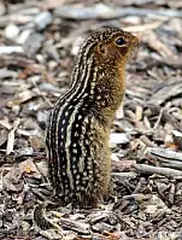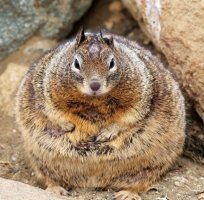 The thirteen-lined ground squirrel is a species of hibernating ground squirrel that is widely distributed over the prairies of North America. It is brownish, with 13 alternating brown and whitish longitudinal lines (sometimes broken into spots) on its back and sides.
The thirteen-lined ground squirrel is a species of hibernating ground squirrel that is widely distributed over the prairies of North America. It is brownish, with 13 alternating brown and whitish longitudinal lines (sometimes broken into spots) on its back and sides.The thirteen-lined ground squirrel is strictly diurnal and is especially active on warm days. In late summer, it puts on a heavy layer of fat and stores some food in its burrow. It enters its nest in October, rolls into a stiff ball, and decreases its respiration from between 100-200 breaths per minute to one breath about every five minutes. It emerges in March or early April. Thirteen-lined ground squirrels prefer open areas with short grass and well-drained sandy or loamy soils for burrows. They avoid wooded areas. Mowed lawns, golf courses, cemetaries, well-grazed pastures, parks and roadsides are common habitats. The burrow may be as much as 6 metres long, with several side passages. Most of the burrow is within half a meter of the surface, with only the hibernation nest in a special deeper section. Shorter burrows are often dug as hiding places to evade predators. The animal is well camouflaged, and frequently stands to keep watch.  Its primary diet includes grass and weed seeds, caterpillars, grasshoppers, and crickets, but this ground squirrel may also eat mice and shrews, and will attack and consume cicadas if able to catch them. It sometimes damages gardens by digging burrows and eating vegetables, but it also devours weed seeds and harmful insects.
Its primary diet includes grass and weed seeds, caterpillars, grasshoppers, and crickets, but this ground squirrel may also eat mice and shrews, and will attack and consume cicadas if able to catch them. It sometimes damages gardens by digging burrows and eating vegetables, but it also devours weed seeds and harmful insects. When preparing for winter hibernation, Thirteen-lined ground squirrels put on a lot of extra weight in the form of fat, so they can survive without eating for six months. Thirteen-lined ground squirrels have excellent senses of vision, touch, and smell. They use alarm calls and other sounds, as well as using special scented secretions, to communicate with other squirrels. They rub glands around their mouth on objects to leave scent marks. They also greet one another by touching noses and lips. This ground squirrel's home range is about 1 hectare (2-3 acres). Thirteen-lined ground squirrels give alarm calls when they sense a predator; all nearby squirrels escape into their burrows. This squirrel's main predators include snakes and hawks. Up to 90% of newborn Thirteen-lined ground squirrels die from predators in their first summer. Once they have reached adulthood, these squirrels probably live for only a few years. |